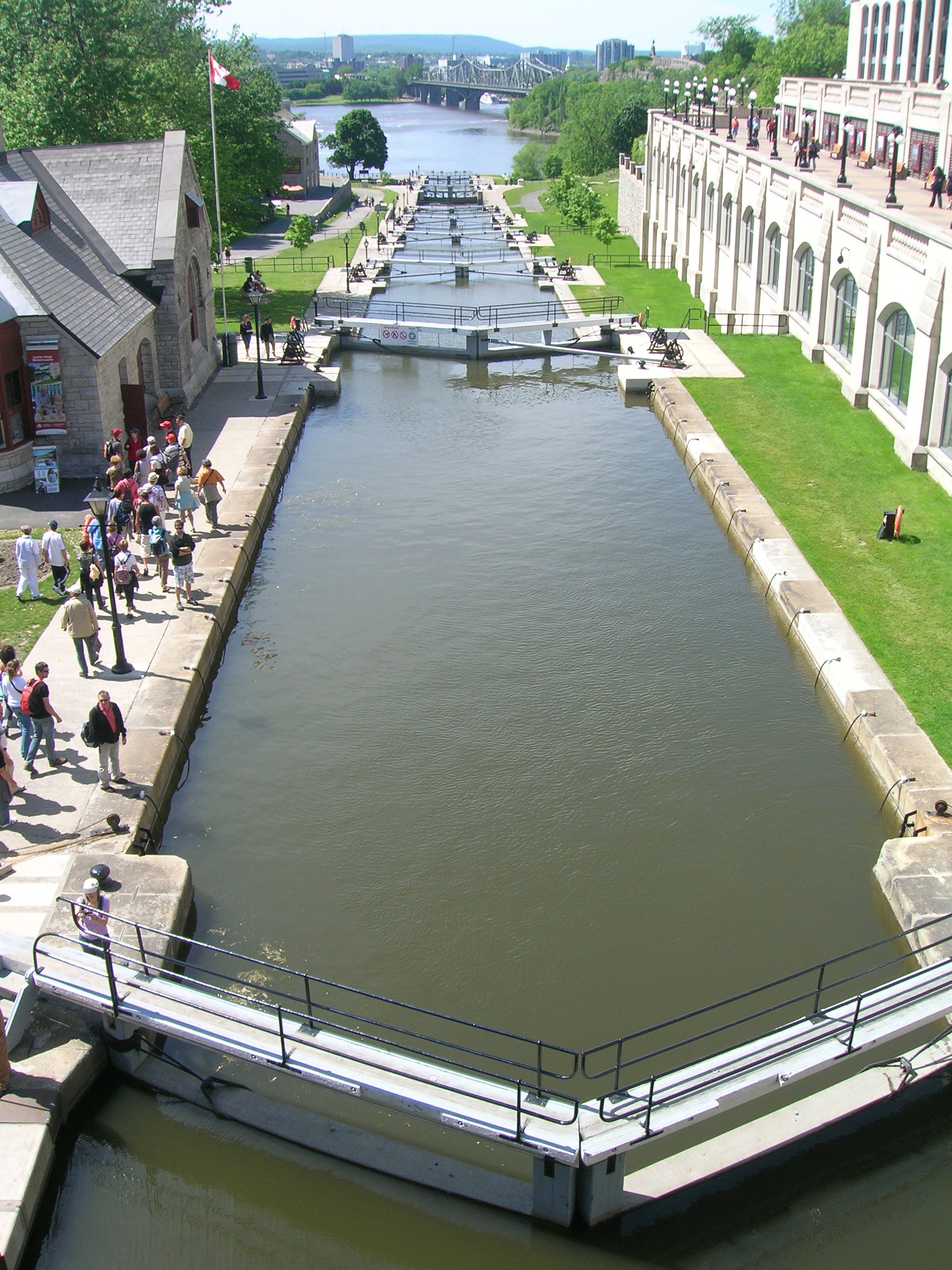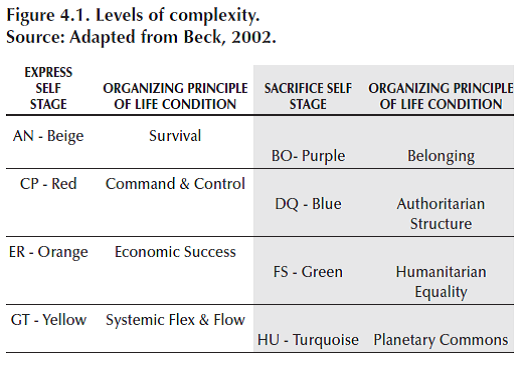Marilyn Hamilton
With this second wave of the Integral Leadership Review – Canada (ILR – C) issue, I imagine, the Rideau Canal lock system symbolizing the environment where our authors interact with the leaders and leadership insights that they have contributed to this special Canada issue.
In the heart of Ottawa, Canada’s national capital, the Rideau Canal provides year round service and engagement to Canadian citizens and society[i].
Figure 1: Rideau Canal “Rideau Canal Locks” by Snowjam – Own work. Licensed under CC BY-SA 3.0 via Wikimedia Commons –http://commons.wikimedia.org/wiki/File:Rideau_Canal_Locks.JPG#mediaviewer/File:Rideau_Canal_Locks.JPG
Now, a UNESCO World Heritage Site, the Rideau Canal, is situated right beside the nation’s parliament buildings (and beside one of Canada’s iconic railway hotels, the Chateau Laurier). Its set of nine locks raise and lower boats between the canal to the Ottawa River below. When it was built (1832) the Rideau Canal was one of the world’s most complex engineering feats– forerunner of both the Suez Canal and the Panama Canal. Even in a digital age, the Rideau Canal’s lock system still holds the record for the greatest number of levels[ii] and it still operates with the beauty and power of the analog technology based on natural gravitation and water flow that the engineers designed for its operation.[iii]
While the Totem © [iv] on our ILR-C cover offers us the Guides to appreciate our world through four lenses, the locks offer us a working pattern that serves us in understanding the context of individual and collective human journeys as we develop our worldviews through the natural hierarchy from egocentric to ethnocentric to worldcentric to kosmocentric. As a fractal-like pattern the locks also remind us of the cultural/social environmental journey from pre-modern, through modern to post-modern and into today’s emerging integral stages of human evolution.
The lock system operates with the natural gravitational flow of water. Like the developmental step-stages the human system naturally traverses as it matures, you cannot skip stages or locks. In other words you can’t take a boat from the lowest level of the Ottawa River to the ninth level of the Rideau Canal without floating up the water staircase of levels. Likewise you cannot lower a boat from the canal level to the river level without stepping down through each lock.[v]
In either direction, an intervener is needed to create the conditions for the staircase of vertical movement. He is called the Lock Master. Carefully he controls the technical mechanism and natural water flow in order to flood each level entirely – so the boats are naturally raised or lowered by the “simple” change of their environment. When the lock master confirms that the lock flooding step is complete, he releases the boats from their temporary environment and allows them to move forward into the next lock to repeat the process. It is the lock master’s job to attentively guide this vertical climb (and even today it is a manual labour (of love and admiration for the design of the system by all accounts)).
To do his job, the lock master is tuned into the natural flows of water, creating conditions for change in the environment. He acts as a catalyst for this change – like the authors in this issue who are not mechanical change agents but much more mindful of how they transform, presence, clarify, engage, educate, influence and voice the flex and flow of the leaders with whom they engage. In so doing our author-lock masters create temporary habitats for the emergence of leaders who can elevate their own and others’ leadership capacities to the requisite level of operation. Such feats of habitat creation, system design and leadership guidance, engendered from reinforcing positively biased neural pathways (as noted by Natasha Mantler’s Leadership Tip – to mind what you do and how you think) enable leaders to gain the complex skills to face impossible tasks in a VUCA[vi] world. Perhaps as lock masters of human emergence, our authors are just as much Waterpreneurs as our Waterlution article from January, 2015 described?
The contribution to our February issue that most powerfully reflects this elevating process comes from Brian and Mary Nattrass, who have literally learned with The Natural Step ™, the natural laws of introducing the concepts of sustainability. They pose the quandary at Our Evolutionary Crossroads: How ARE We to Go On Together? As we worked with them on preparing their article for this issue, we marvelled at the practicality of their approach to teaching sustainability to the largest global players, while never losing the awe they hold for the Kosmos. Yet the process they designed for their clients in re-framing the Old Story into the New Story, does indeed seem to have many of the features of floating vessels through a lock system – with the greatest of care. The Nattrasses themselves realized their work demands them to be “step down transformers” that enable the New Story (symbolically at the highest level) to gradually flow into the Old Story so that the vessels are gradually floated into a whole new level of capacity and influence. But they are also “step up transformers” as they design the transmutation of the Old Story so that the vessels that include organizations, teams and individuals can be floated in an aligned and coherent way through the system to a new level of capacity for all.
Gervase Bushe, in his interview with Russ Volckmann, explains the progeny of Dialogic Development – his collaboratively developed organization development (OD) work. Gervase shares the years of observing leaders’ attempts to learn how to be effective not only in the complicated conditions of organizations that modernity spawned but how to self-organize those capacities for effectiveness in a truly unpredictable VUCA world. As a lock master who has prototyped OD with the pioneers of Appreciative Inquiry (David Cooperrider), Adult Development (Jane Loevinger, Bill Torbert) and Complexity (Peggy Holman), Bushe’s story reminds us that the lock master’s practise of designing habitats for human emergence is a never-ending quest[vii].
Likewise Olen Gunnlaugson in Deep Presencing: Illuminating New Territory at the Bottom of the U, seemingly plunges down into the lock master’s realm to explore “at the bottom of the lock” – what is happening to all the boats who are traversing the locks at the same time. Olen seems to ask: What and how can we become aware of the collective experience of ourselves as vessels and our “ground” as the level of the water we float in together changes – even as we are traversing the staircase of development (if not evolution)?
Meanwhile as we consider this metaphor of the lock system, Ian Wight offers those of us who would like to teach integrally informed lock masters, the new curriculum for the 21st Century. Wight proposes new integral framings for such teachings in his From Practice to Praxis as Transformative Education: Leading at the Integral/Professional Interface? His suggestions strongly affirm that the teachers of lock masters must themselves become aware of their own prowess on the vertical journey of personal development as a critical and necessary commitment to mastery.
With such a curriculum we must ask ourselves as learning vessels of the new Story (and echoing the Nattrass’ query of “how can we go on together?”) – Rebecca Colwell’s question: Will the Next Buddha be a Sangha? Responding to the Call to Influence the Future of Collaboration. In other words she suggests that we will not float our own boat alone – not to mention all the other boats in our collaborative cohorts – we will do this together. Her article opens a path for us to expand both our individual and collective intelligence as sailors, captains, boaters, navigators, as well as lock masters on/with/as the rivers of life.
As we survey the types of vessels traversing the lock system from Old Story to New Story, Diana Claire Douglas reminds us what an impact the “voices of our vessels” can offer, in her review of the book Integral Voices on Sex, Gender, and Sexuality: Critical Inquiries, edited by Vanessa Fisher and Sarah Nicholson.
Lastly in exploring the step-up-step-down journeys of our progressions through the locks of our lives, Tim Merry adds more verse to our Poetry Gallery – not only declaring in Superman: “Out of the box/ Not even wearing socks/ Naked to the core/ Wounds raw/ Soul sore/ Ready to explore/ The new Shore”, but reminding us in The Mother that we are:
Always connected and always alone:
Water, sky, fire, earth, stone
Mind, heart, flesh and bone.
Attunement to ancient rhythm
Indigenous wisdom
Passed on by elders
Welders
Of the generations
and all our relations
Connectors to creation.
With Merry’s passage we can now flow out of the last lock into the canal – and turn around and view the whole issue of Integral Leadership Review – Canada once more through the lenses of our four quadrant Totem[viii]. With guidance from Bear, Wolf, Raven and Salmon we see that the intelligences for multi-perspectival worldviews have been captured in the rich stories of the January issue, while the lock masters of the Rideau Canal have elevated us in February, to emerge capacities that can serve a world in urgent need of the leadership presaged by Adrienne Clarkson[ix]. Her vision of the contribution of leadership in Canada to the world is that we enable the boats in our lock system to be not only guided by our four Totems but that all the levels contribute to a healthy society. Our job as leaders, is to “search for our common humanity, for the decency, the understanding and the generosity” that flows in the water of the bio-psycho-cultural-social lock system where our authors have showed us how to flood the birthing canals of human evolution with a “World Legacy Light”.
References
Beck, D., & Cowan, C. (1996). Spiral Dynamics: Mastering Values, Leadership and Change. Malden, MA: Blackwell Publishers.
Beck, D. (2002). Spiral Dynamics in the Integral Age. Paper presented at the Spiral Dynamics integral, Level 1, Vancouver, BC.
Graves, C. (2003). Levels of Human Existence: Transcription of a Seminar at Washington School of Psychiatry, Oct. 16, 1971. Santa Barbara: Eclet Publishing.
Graves, C. (2005). The Never Ending Quest: A Treatise on an Emergent Cyclical Conception of Adult Behavioral Systems and Their Development. Santa Barbara, CA: ECLET Publishing.
Hamilton, M. (2008). Integral City: Evolutionary Intelligences for the Human Hive. Gabriola Island BC: New Society Publishers.
Wilber, K. (1995). Sex, Ecology and Spirituality: the spirit of evolution. Boston: Shambhala Publications Inc.
Wilber, K. (2000). Integral Psychology. Boston: Shambhala Publications Inc.
ENDNOTES
[i] Seeing the Rideau Canal as I describe here, was inspired by Don Beck, who was so delighted with its practical symbolism in 2004 when we were delivering Spiral Dynamics integral ™ training, that he set off with a camera and met the lock master.
[ii] Not only the nine that connect the Rideau Canal to the Ottawa River but 34 more along the whole waterway. http://en.wikipedia.org/wiki/Rideau_Canal
[iii] In my formative teenage years I was privileged to grow up in Ottawa – Canada’s national capital. My father was Director of National Historic Sites and I had exposure to the front line of Canada’s emerging internal and external roles in the world. I attended parliament regularly, witnessed the inaugural raising of Canada’s maple leaf flag, visited our national artefacts and treasures and dined with international cultural and historical experts. The early 60’s were a turbulent time in Canada’s history and I soaked (egocentrically unaware of my privilege) in the heady interpretations of the emerging story of who we were in the world, shapeshifting from modern to post-modern
[iv] ©2014 Aboriginal Nations Education, Greater Victoria School Board, BC, Canada. Artist Jamin Zurowski.
Bear/UL. Wolf /LL. Raven/UR. Salmon/LR.
This Totem is a Gift used with permission on the cover of this Canada Issue. Please do not reproduce without © Permission.
[v] Quoted from Hamilton (2008, pp.85-86):
Graves in the 1960s and 1970s …conducted an 18-year study, whose conclusions came to be known as the “evolutionary complex levels of human existence.” Graves’ research showed that human behaviors arising out of one set of conditions created problems of existence that could not be solved at that level (echoing Einstein’s proposition of the same nature). As a result new adaptive behaviors are called into existence. Graves identified a group-centric cluster of behaviors he called “sacrifice self” values and an individualcentric cluster of behaviors he called “express self” values. Moreover, his research showed that these behaviors adapted and alternated with one another at an ever-increasing level of complexity, as life conditions changed. Graves used a set of identifiers to represent life conditions (designated by letters from the first half of the alphabet) and bio-psycho- cultural-social human existence (designated by letters from the second half of the alphabet) (see Figure 4.1). Beck and Cowan (1996) … have devised a system of color codes to identify each level of complexity. Beige, red, orange and yellow (i.e., warm colours) relate to “express self” versions of existence. Purple, blue, green and turquoise (i.e., cool colours) relate to “sacrifice self” versions of existence (see Figure 4.1).
[vi] VUCA stands for Volatile, Uncertain, Complex and Ambiguous – as coined by the military.
[vii] This is reminiscent of Clare Grave’s (2005) description of our biopsychosocial journey as a “Never Ending Quest”.
[viii] The Rideau Canal has graduated into a modern-day entertainment and sports facility – freezing 7 kilometers of ice that become the inner city super highway for skaters throughout the winter months. Symbolically this frozen river allows us to “practice” enjoying life at the highest level through a natural – and shared – “state change” experience.
[ix] In both waves of this Canada issue our contributors have spanned the country from east coast to west coast and many points in between – as we show you in our Map and Biographies of Authors.



